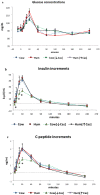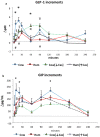Neither Incretin or Amino Acid Responses, nor Casein Content, Account for the Equal Insulin Response Following Iso-Lactose Loads of Natural Human and Cow Milk in Healthy Young Adults
- PMID: 35458186
- PMCID: PMC9026711
- DOI: 10.3390/nu14081624
Neither Incretin or Amino Acid Responses, nor Casein Content, Account for the Equal Insulin Response Following Iso-Lactose Loads of Natural Human and Cow Milk in Healthy Young Adults
Abstract
Human milk contains <50% less protein (casein) than cow milk, but is equally effective in insulin secretion despite lower postingestion hyperaminoacidemia. Such potency of human milk might be modulated either by incretins (glucagon-like polypeptide-1,GLP-1); glucose-inhibitory-polypeptide, GIP), and/or by milk casein content. Healthy volunteers of both sexes were fed iso-lactose loads of two low-protein milks, i.e., human [Hum] (n = 8) and casein-deprived cow milk (Cow [↓Cas]) (n = 10), as well as loads of two high-protein milks, i.e., cow (n = 7), and casein-added human-milk (Hum [↑Cas]) (n = 7). Plasma glucose, insulin, C-peptide, incretins and amino acid concentrations were measured for 240′. All milks induced the same transient hyperglycemia. The early [20′−30′] insulin and C-peptide responses were comparable among all milk types apart from the low-protein (Cow [↓Cas]) milk, where they were reduced by <50% (p < 0.05 vs. others). When comparing the two high-protein milks, GLP-1 and GIP [5’−20’] responses with the (Hum [↑Cas]) milk were lower (by ≈2−3 fold, p < 0.007 and p < 0.03 respectively) than those with cow milk, whereas incretin secretion was substantially similar. Plasma amino acid increments largely reflected the milk protein content. Thus, neither casein milk content, nor incretin or amino acid concentrations, can account for the specific potency of human milk on insulin secretion, which remains as yet unresolved.
Keywords: amino acids; casein; cow milk; dietary supplements; human milk; incretin; insulin; whey proteins.
Conflict of interest statement
The authors declare no conflict of interest.
Figures









References
-
- Lionetti L., Cavaliere G., Bergamo P., Trinchese G., De Filippo C., Gifuni G., Gaita M., Pignalosa A., Donizzetti I., Putti R., et al. Diet supplementation with donkey milk upregulates liver mitochondrial uncoupling, reduces energy efficiency and improves antioxidant and antiinflammatory defences in rats. Mol. Nutr. Food Res. 2012;56:1596–1600. doi: 10.1002/mnfr.201200160. - DOI - PubMed
MeSH terms
Substances
LinkOut - more resources
Full Text Sources
Medical

